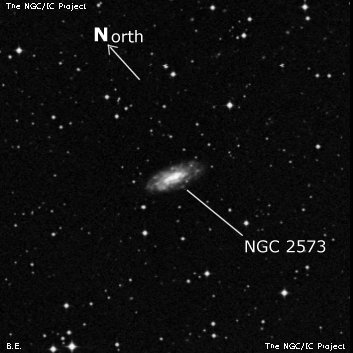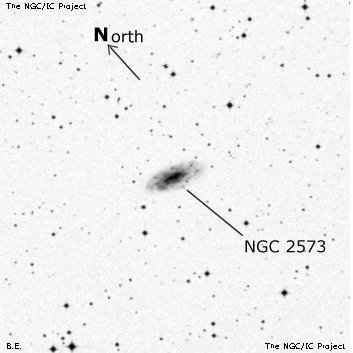NGC/IC Project Restoration Effort
(This is a very very beta version)
NGC2573


Basic Information
Location and Magnitude
Right Ascension: 1:41:53.2
Declination: -89:20:3
Constellation: OCT
Visual Magnitude: 13.5
Historic Information
Discoverer: Herschel J.
Year of discovery: 1837
Discovery aperture: 18.3
Observational
Summary description: F, S, R, glbM, Polariss Austr
Sub-type: SBc
Steve's Notes
=====
NGC 2573
30" (10/15/15 - OzSky): at 303x "Polarissima Australis" appeared moderately bright and large, very elongated at least 3:1, ~1.5'x0.5'. Contains a small bright core and a sharp stellar nucleus (possibly a star?). Mag 10.3 HD 23641 is 7.4' WNW.
NGC 2573 is the brightest of three galaxies close to the south celestial pole with NGC 2573A and 2573B 32' WNW. NGC 2573A is the fainter of a colliding pair at 1.3' separation with NGC 2573B. At 303x it appeared very faint to faint, moderately large, very elongated 7:2 ~N-S, ~0.7'x0.2', low surface brightness. NGC 2573B is fairly faint, very elongated 3:1 [PA 125¡], 0.6'x0.2', fairly low surface brightness. The major axis is extended in the direction of NGC 2573A. A mag 13 star is 1.2' N. Images reveal an apparent bridge between the galaxies and plumes, tidal tails and knots (particularly with NGC 2573A). The outer tidal plumes were not seen based on my size estimate.
24" (4/5/08 - Magellan Observatory, Australia): NGC 2573 is known as "Polarissima Australis" and is located only 40' from the south celestial pole. At 260x it appeared fairly faint, moderately large, very elongated 7:2, ~1.6'x0.45'. Contains a very small, bright nucleus with much fainter extensions. A mag 10.6/11.2 pair at 7" separation was picked up 13' NNE. This galaxy was brighter than I expected based on descriptions I've read.



